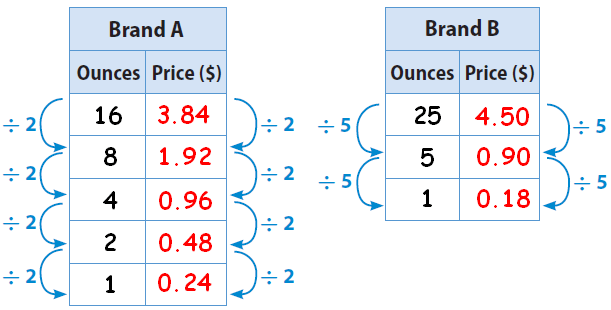USING RATES TO COMPARE PRICES
Subscribe to our ▶️ YouTube channel 🔴 for the latest videos, updates, and tips.
A rate is a comparison of two quantities that have different units.
Let us look at some examples to understand how rates can be used to compare prices.
Example 1 :
Lily has two job offers. One is paying $160 for 8 hours and other one is paying $95 for 5 hours. Can you help Lily to choose the better job?
Solution :
In both the jobs, salary is given for different hours. To compare the two jobs, we have to convert the salaries into unit rates.
That is, we have to find the salary for 1 hour.
In job 1,
salary for 1 hour = 160/8 = $20 per hour
In job 2 ,
salary for 1 hour = 95/5 = $19 per hour
Conclusion :
When we compare the unit rates of both the jobs, Lily gets $1 more in the first job.
So, the first job is preferable.
Example 2 :
Michael is at the grocery store comparing two brands of juice. Brand A costs $3.84 for a 16-ounce bottle. Brand B costs $4.50 for a 25-ounce bottle. Which brand is the better buy?
Solution :
To compare the costs, Michael must compare prices for equal amounts of juice.
That is, he has to compare prices of one ounce of each juice.
We can get the price of 1 ounce of each juice as given below.

From the above tables,
brand A costs = $0.24 per ounce
brand B costs = $0.18 per ounce
When we compare the unit prices of the two brands given above, it is better to buy brand B.
Example 3 :
David covers 600 miles in 8 hours and John covers 380 miles in 5 hours. Who is driving faster?
Solution :
Distance covered by David in 1 hour is
= 600/8
= 75 miles per hour
Distance covered by John in 1 hour is
= 380/5
= 76 miles per hour
When we compare the above unit rates (Distance covered in 1 hour), John is driving faster than David.
Subscribe to our ▶️ YouTube channel 🔴 for the latest videos, updates, and tips.
Kindly mail your feedback to v4formath@gmail.com
We always appreciate your feedback.
About Us | Contact Us | Privacy Policy
©All rights reserved. onlinemath4all.com
Recent Articles
-
AP Calculus BC Problems with Solutions
Dec 20, 25 10:51 AM
AP Calculus BC Problems with Solutions -
AP Precalculus Problems and Solutions (Part - 1)
Dec 20, 25 10:49 AM
AP Precalculus Problems and Solutions (Part - 1) -
AP Calculus AB Problems with Solutions (Part - 1)
Dec 20, 25 10:49 AM
AP Calculus AB Problems with Solutions (Part - 1)
